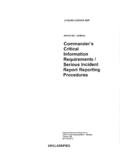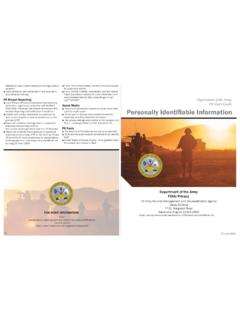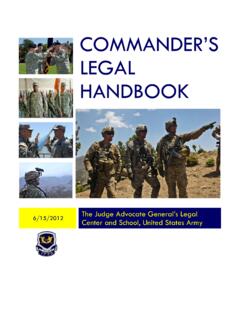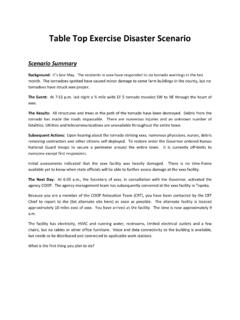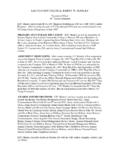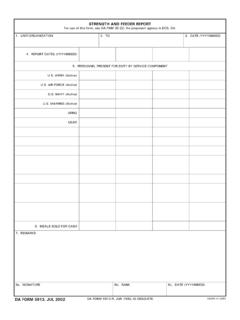Transcription of Standing Operating Procedures (SOP) - TAG Home …
1 Standing Operating Procedures (SOP). FOOD SERVICE OPERATIONS FOR. GARRISON AND FIELD FEEDING. KANSAS ARMY NATIONAL GUARD. REVISED 15 September 2014. JFHQ-J4 (Logistics). 2737 SOUTH KANSAS AVENUE. TOPEKA, KANSAS 66611. APPROVED BY. MSG LARRY DEW. FOOD PROGRAM MANAGER. 1. PURPOSE : This has been developed to establish local and standardized Procedures by which units in the KSARNG, with garrison and field food service operations, can carry out routine operations, reports, and administrative functions associated with Food Service operations. 2. REFERENCES: AR 30-22 30 August 2003 The Army Food Service Program DA PAM 30-22 30 August 2003 Operating Procedures for the Army Food Program AR 600-38 11 March 1988 The Meal Card Management System FM 10-23 18 April 1996 Army Field Feeding Procedures FM 10-23-1 March 1992 Commander's Guide to Food Service FM 10-23-2 November 1991 Preparations and Serving of Food in Garrison FM 21-10 November 1988 Field Sanitation FM 21-10-1 October 1989 Unit Field Sanitation Team TB MED 530 October 2002 Food Service Sanitation TM 10-412 November 1991 Army Recipe Cards 3.
2 DEFINITIONS and ABBREVIATIONS: a. Production Schedule (PS): DA form 3034 gives cooks detailed information and special instructions for preparation, serving, and accountability of food and food items. b. Kitchen Police (KP): Personnel detailed by the 1SG to clean related food service equipment and to assist, as needed, the FOS or 1st Cook in limited food preparation. This includes, but not limited to, paring of fruits and vegetables and/ or serving. Dining Room Orderly's (DRO) will be assigned from the KP staff to keep the dining room clean before, during, and after meals. Sometimes referred to as Dining Facility Attendants (DFA) . c. Food Preparation Area: The area designed to prepare, cook and/or serve food. d. Pantry: The room/ locker/ place where food and related food items are stored for future use. The food service manager will have an inventory of items stored in this room.
3 E. Equipment Storage/Ware Room: All utensils used in the prep and serving of food will be arranged in an orderly manner and secured in a way that protects the utensils and personnel. f. Portions: Amount of food authorized per individual. g. Rations: Amount of food required to feed each person three (3) Meals per day. h. Ration Cycle: Cycle of the type of rations to be fed during a 24 hour period (ie: A-MRE,T-MRE-T, A-A-A, ect). i. Recipe Cards: (TM 10-412) The standard Army recipe card service to be used by FS. personnel as a guideline in preparing food for serving. j. Food Management Board: KSARNG has an Installation Menu Board which establishes menus to serve locally preferred menu items, and increase or decrease items due to supply demands and troop accountability. k. Dining Facility Advisory Council: Each unit providing food services will have an advisory council to recommend to the Food Service Manager desired adjustments to the menu to meet customer preferences or services that will provide a more effective food service program.
4 4. FORMS: a. da form 5913 -R (Strength and feeder report ) is a multi-purpose form . When used as a request, this form is filled out and signed by the Commander ONLY and submitted to the FOS 30 days prior to the scheduled IDT training period. It is used to project anticipated headcount for training periods during IDT and AT. It can be used to project headcount up to 3 days on one form . b. da form 5913 -R (Strength and feeder report ): This form , when used as a report , is used to report headcount requested data. Actual present for duty (PDS) strength is entered on this form . Any difference between headcount requested and actual PDS must be explained by the Unit Commander. c. DA form 3294-R (Request for Issue of Rations) is used by the FOS to order specific menus as depicted in the OPORD. This form is forwarded to LANG-J4-FS for funding.
5 D. DA form 3034 (Production Schedule) is used as instructions to the cooks to prepare food items. Recipe card numbers and special instructions are entered on this form . It is the middle link in the audit trail. e. DA 5914-R (Ration Control Sheet) is used to record disposition of rations and number of soldiers supported. f. DA 4538-R (Abstract of Sales) is an obsolete form . It has been replaced by DA form 7454. g. DA form 7454 (Monthly Earnings and Expenditure Record) is used to identify all monetary transactions affecting the DFAC account during on accounting period (monthly). 5. DUTIES and RESPONSIBILITIES: a. Logistics Officer (S/4): 1. Plan and coordinate the food service operations. 2. Plan and coordinate the ration cycle with supply source (LP, Prime Vender, TISA. Commissary, ect.). 3. Plan and organize the ordering of all supplies necessary to operate the garrison dining facility (food, paper products, cups, fuel, ect.)
6 4. Ensure enough equipment is on-hand to support each feeding site (ie. Insulated food containers, beverage dispensers, and serving utensils) in addition to the normal kitchen operations. 5. Monitor the overall feeding operation. 6. Coordinate with Food Service Officer and Food Ops Sgt on the feeding cycle, meal times, proposed feeding sites, and methods of delivery. b. The Commander will ensure that: 1. Soldiers are subsisted adequately and that the garrison dining facility/ field kitchen operation is operated properly. 2. Food service personnel are working in their primary MOS and that an adequate number of FS personnel and equipment necessary are assigned, and on-hand, to accomplish the mission at hand. 3. Assigned FS personnel are properly trained and proficient in the transportation, storage, preparation, serving, and recovery of subsistence items at the level of FS.
7 Operations applicable to their skill level. 4. RCSS (Reserve Component Subsistence System) Procedures are correctly implemented. 5. Implement measures to conserve, safeguard, and account for all related subsistence supplies requested, issued, prepared, and served. 6. The FS operation conforms to highest obtainable standards in food preparation, service, atmosphere, and sanitation by talking to soldiers, visiting the dining facility (DFAC) and food prep areas to observe FS operations, first hand, the actual storage, prep, cooking, and serving of meals. Take necessary action to correct deficiencies that are noted. 7. All authorized food service preparation and serving equipment are available and operational. 8. All soldiers receiving BAS are placed on payroll deduction during operations under RCSS (AR 600-38). c. Food Service Officer (FSO): The officer assigned by the Company Commander to act as the liaison between the food service section and the company commander.
8 S/he is responsible for the proper operation and conduct of the food service section. Some of the FSO's major duties, but not limited to, are described in FM 10-23-2 (Food Prep & Class 1 Management). 1. Plan and coordinate ration requirements with the FOS to ensure assets are adequate and in-place to support the unit's mission. 2. Establish ration requirements and monitor effectiveness of operation. 3. Coordinate with First Sergeant and FOS on a daily basis to evaluate headcount operations and ensure that the number of meals requested is in line with number of personnel requiring support from each site. 4. Coordinate with First Sergeant and FOS on a daily basis to evaluate any changes to the feeding plan and any changes in the unit's mission. 5. Randomly select figures entered on DA form 3234-R (Inventory Record) and cross check against receiving documents to ensure all food items are accounted for.
9 6. Oversee cash meal payment Procedures (DD form 1544). 7. Monitor accounts status to ensure enough food is being received and issued to the troops and disposition of overstock for credit. 8. Inspect field kitchen equipment to ensure all equipment is being maintained in a clean, serviceable, and in Operating condition. 9. Assist the FOS in acquiring repair parts. 10. Act as liaison between the commander and the FOS on all matters relating to the food service operation. 11. Assist in developing an OJT program for inexperienced food service personnel. 12. Establish, prepare, and conduct safety meetings. 13. Monitor sanitation training. 14. Establish and direct the energy conservation and management plan for the DFAC and facilities. 15. Monitor DFAC account to ensure that all materials, supplies, and food are being properly accounted for.
10 16. Develop and execute a physical security plan. d. First Sergeant (1SG): 1. Provide an estimated headcount projection to the FOS at least seven (7) days prior to any training period/exercise, and an actual headcount is given in enough time to allow the FOS to adjust the amount of food to be prepared. 2. Identify separate headcount strength for each remote feeding site and provide information to the FOS. 3. Indentify and relay any changes to the feeding requirements or mission changes that may affect the food service operation. 4. Monitor the garrison and field kitchen activities. 5. Monitor the food safety and field sanitation team activities. 6. Assign KP's, headcounter, and details to the garrison and field kitchen. The KP detail should be detailed to the kitchen immediately after morning formation. As a minimum, a portion of the KP detail should be detailed to the field kitchen prior to departure to field site and the remainder detailed upon arrival to the FTX site.


